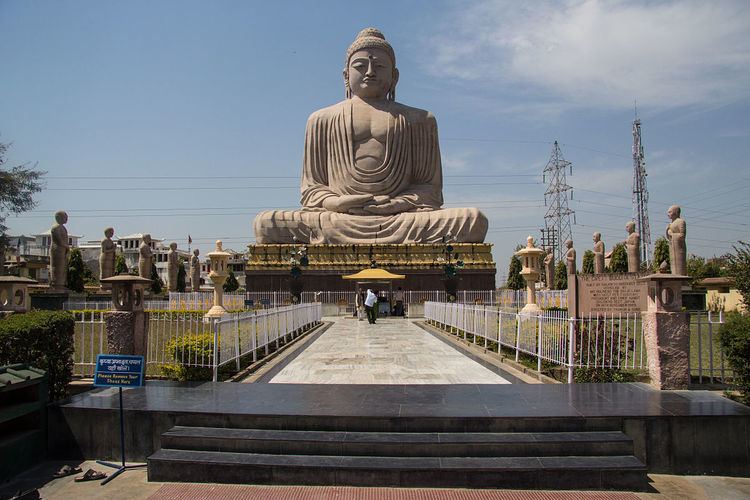 | ||
In religion and spirituality, a pilgrimage is a long journey or search of great moral significance. Sometimes, it is a journey to a sacred place or shrine of importance to a person's beliefs and faith. Members of every major religion participate in pilgrimages. A person who makes such a journey is called a pilgrim.
Contents
- Primary sites
- Buddhist pilgrimage sites in India
- Further sites
- Pemayangtse Monastery
- Tawang Monastery
- Zang Dhok Palri Phodang
- Rumtek Monastery
- Enchey Monastery
- Tashiding Monastery
- Dubdi Monastery
- Ralang Monastery
- References
There are number of historical Buddhist pilgrimage sites in India.
Primary sites
Buddhism offers four major sites of pilgrimage: the Buddha's birthplace at Lumbini, the site where he attained Enlightenment Bodh Gaya, where he first preached at Benaras, and where he achieved Parinirvana at Kusinagara. Some Buddhist pilgrimage sites in India are listed below:
These are three of the four holiest sites in Buddhism. The fourth, Lumbini, the birthplace of the Buddha, is now in southern Nepal.
Buddhist pilgrimage sites in India
The name of Bihar is derived from vihara, meaning monastery, such was the association of the area with Buddhism. In addition to these sites which were visited by the Buddha, other sites in India have become notable
There are a proliferation of Tibetan Buddhist sites in India
Further sites
Pemayangtse Monastery
The Pemayangtse Monastery is a Buddhist monastery in Pemayangtse, near Pelling in the northeastern Indian state of Sikkim, located 140 kilometres (87 mi) west of Gangtok.
Tawang Monastery
Tawang Monastery in the Indian state of Arunachal Pradesh is the largest monastery in India and second largest in the world after the Potala Palace in Lhasa, Tibet.
Zang Dhok Palri Phodang
Zang Dhok Palri Phodang is a Buddhist monastery in Kalimpong in West Bengal, India. The monastery is located atop Durpin Hill, one of the two hills of the town. It was consecrated in 1976 by the visiting Dalai Lama.
Rumtek Monastery
Rumtek Monastery also called the "Dharmachakra Centre", is a gompa located in the Indian state of Sikkim near the capital Gangtok. It is a focal point for the sectarian tensions within the Karma Kagyu school of Tibetan Buddhism that characterize the Karmapa controversy.
Enchey Monastery
Enchey Monastery is located in Gangtok, the capital city of Sikkim in the Northeastern Indian state. It belongs to the Nyingma order of Vajrayana Buddhism.
Tashiding Monastery
Tashiding Monastery is a Buddhist monastery of the Nyingma sect of Tibetan Buddhism in Western Sikkim, northeastern India. It is located on top of the hill rising between the Rathong chu and the Rangeet River.
Dubdi Monastery
Dubdi Monastery, occasionally called 'Yuksom Monastery' is a Buddhist monastery of the Nyingma sect of Tibetan Buddhism near Yuksom, in the Geyzing subdivision of West Sikkim district.
Ralang Monastery
Ralang Monastery is a Buddhist monastery of the Kagyu sect of Tibetan Buddhism in southern Sikkim, northeastern India. It is located six kilometres from Ravangla.
